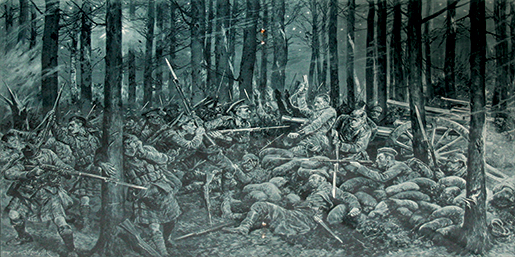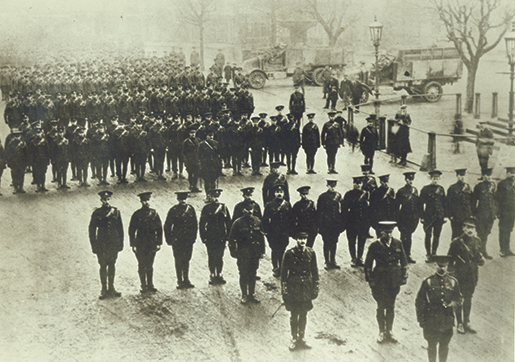How the artillery became the principal weapon of warfare

Britain’s 28th Division, made up largely of regular soldiers from the far reaches of the Empire, reported 15,533 losses—80 per cent of its strength—until exhaustion and ammunition shortages forced the generals on both sides to call the battle off.
The British official historian L.E. Edmonds described the 33-day bloodletting as “the first of a new kind of battle in which the enemy infantry would merely occupy ground” from which artillery and poison gas “had driven every living creature.”
The French and British armies were totally unprepared for this kind of warfare. They lacked reliable air observation, signals equipment and above all, heavy artillery able to disrupt the enemy through counter-battery fire. This situation ought to have led to a carefully staged withdrawal, conserving men and the limited supply of artillery shells. But under pressure from the French army, Field Marshal Herbert Kitchener and his generals continued an action that preserved a small part of the salient and the ruined city of Ypres at a cost of 60,000 casualties.
After Canada’s brave, battered infantry battalion was withdrawn, the artillery continued in action. Canada’s artillery followed the British model in every respect. Each of three infantry brigades was supported by an artillery brigade of 800 officers and men in three batteries each of six light field guns. The British identified their field artillery by the weight of the shell. The 18-pounder was used throughout the war, until it was replaced by the 25-pounder in the Second World War.
Each gun was towed into position by a team of four horses. The horses were unhitched and withdrawn to a safe distance, and the battery commander then worked out the tasks the gunners were to carry out by observation of the ground. Ideally, an airplane was available to help register the guns on every position, using elementary hand signals to communicate with the gunners. The effective range of the 18-pounder was 4.5 to 5.5 kilometres, but close support of the infantry usually meant taking up positions one to two kilometres behind the front line.
During training, the emphasis was on mobility, as the generals continued to insist that trench warfare was temporary and would soon be broken by aggressive offensive action. The French army was determined to evict the enemy from the soil of France in 1915 and British support was required.
This doctrine led to the decision to arm the guns with shrapnel shells, which on contact with the ground would eject iron pellets to wound or kill troops unable to take cover. High-explosive shells became available in limited numbers by 1915, but the explosive charge was not powerful enough to damage field fortifications. Rapidity of fire and manoeuvrability, and not the firepower of heavier, longer guns, was thought by both the French and British to be the key to victory.
One of the main consequences of pre-war assumptions about future conflict was the failure of the War Office to prepare for a protracted battle. Each gun carried 24 rounds of ammunition and was accompanied by a second horse team towing a steel-body wagon with 38 additional rounds. Resupply depended on the availability of wagons and horses from the brigade ammunition column and on reserves of ammunition.
The British and Canadian divisions also deployed a single battery of four 60-pounder guns with an effective range of nine kilometres. This battery, together with a brigade of 18 medium 4.5-inch howitzers, ranged to 6.4 kilometres and provided high-angle, plunging fire, which in theory could destroy field fortifications and carry out vital counter-battery attacks.
There were two problems in 1915: a limited supply of ammunition and a limited ability to calculate the wind speed or direction in the shell trajectory. The result was probable errors in accuracy of 45 to 140 metres for both range and line. The medium batteries were therefore supplied with shrapnel shells to assist the field artillery, while the 60-pounders depended on air observation and good luck.
When the Canadians arrived in the Ypres Salient, the 2nd and 3rd Brigades, Canadian Field Artillery (CFA) took up positions behind their infantry. Lieutenant-General Edwin Anderson, the divisional commander, had been ordered to hold the forward trenches at any cost and to counterattack immediately if any trench was lost. This meant the artillery was to stay put unless ordered to withdraw, so it was necessary to dig in and protect the guns.
The Canadian heavy guns were needed elsewhere, so there was no prospect of counter-battery fire. As G.W. Nicholson notes in his book, The Gunners of Canada, once the Germans had broken through, exposing the division’s flank, “there were now 12,000 yards to be covered by thirty-two 18-pounders and eight 4.5-inch howitzers—or 300 yards per gun.”
The four batteries of the 2nd Brigade, CFA were suddenly thrust into a front-line role with guns firing over open sights at close range. The 10th battery of 3rd Brigade, CFA was also drawn into the battle for the flank, turning its guns north in a heroic effort to prevent a breakthrough near St. Julien. The rest of 3rd Brigade, CFA remained in position behind Gravenstafel Ridge until common sense prevailed and they were withdrawn to a secondary defensive line one kilometre to the rear.
Unfortunately, the infantry battalions were left in place, so when the second gas attack began, the guns were out of range and the enemy broke through on a wide front. By April 26, the Canadian infantry was out of the front line and in reserve, but all three artillery brigades remained in place, supporting a series of abortive counterattacks by British and Indian army divisions.
The German army had prepared for offensive operations by providing each corps with heavy artillery and each army with super-heavy or siege artillery. Used originally to overcome the Belgian and French frontier forts, the heavies, including a 17-inch gun, were now available at Ypres. The power of the German counter-bombardment is a constant theme in Allied accounts of the battle. The Canadian Divisional Artillery war diary is typical: “25 April, batteries very heavily shelled and telephone lines continually cut…men and officers feeling strain of continued fighting and unceasing shell fire.”
The struggle and strain continued through another week of calls for artillery to support yet another British or French attempt to recapture lost ground. Orders to withdraw to a rest area finally came on May 3, leaving the Princess Patricia’s Canadian Light Infantry, then part of the 27th British Division, as the only Canadians still left in the salient.

McCrae was unwilling to wait and volunteered to become the surgeon of the 1st Brigade, CFA. The brigade was in reserve when the German attack began, but was soon fully committed to the defence of Ypres and the Canal Line. McCrae’s Advanced Dressing Station was just west of the Ypres–Yser Canal, within sight of the Germans on Mauser Ridge. The rough dugouts, built into mounds of earth left over from digging the canal, were later enlarged and protected by concrete. Visitors who make the pilgrimage to the “Essex Farm Dressing Station” on the Western Front need to remember how primitive conditions were in 1915 when, during a lull in the battle, McCrae composed the best-remembered poem of the war, “In Flanders Fields.”
McCrae described the rough wooden crosses placed over just-dug graves, not the neat, orderly rows of tombstones at nearby Essex Farm Cemetery. The poem’s third verse, which begins “Take up our quarrel with the foe,” was written in the context of the horrors of Second Ypres and the death of his close friend, Lieutenant Alexis Helmer.
After the artillery withdrew for a brief rest, McCrae left to join the No. 3 Canadian General Hospital (McGill) at Boulogne-sur-Mer, France. His beloved gunners were soon back in action in France at Aubers Ridge, Festubert and Givenchy. They, along with the rest of the British Expeditionary Force, worked hard to overcome the difficulties encountered in 1915.
Several refinements in artillery warfare developed during this time, such as the assignment of a squadron of aircraft to each corps for air observation. Experiments in flash spotting and sound ranging—where a sound-detection crew measures the difference in time between the flash and the sound of a gun to determine its range—led to the establishment of Field Survey Sections, crucial to the development of accurate counter-battery fire. Accurate maps, methods for calibrating the muzzle velocity of guns and better meteorological reports, known as “meteors,” were also developed.
Another major change that increased the effectiveness of the artillery was the creeping barrage, which emerged through trial and error. The idea of “lifting” fire forward in front of advancing troops was tried in 1915, but the optimum method was determined in 1916 during the Battle of the Somme. One 18-pounder per 14 metres of front with timed lifts of 90 metres could neutralize the enemy in forward positions by keeping their heads down.
The creeping barrage did not solve the riddle of the trenches or end the war, but it did emphasize that artillery had become the principal weapon system of the war. This new reality was evident at Vimy Ridge, where the density and depth of fire support allowed the infantry to reach most of its objectives in the time allocated by the artillery program. The artillery had come of age.
Advertisement












